You’ll optimize cellular repair by consuming 0.5 to 2 cups of fresh berries daily, delivering 300-400 mg of polyphenols that clinical studies show provide measurable DNA protection. Fresh berries outperform powders and juices because they maintain intact anthocyanins and flavonoids. Consistency matters more than intermittent consumption—spreading your intake throughout the day maintains steady antioxidant levels. This dosage activates your body’s endogenous repair mechanisms while downregulating inflammatory pathways that damage cells at the molecular level.
How Berry Antioxidants Target Cellular Damage at the Molecular Level

When you consume berries, their powerful phytochemicals immediately begin targeting cellular damage through precise molecular mechanisms.
These compounds downregulate your NF-κB inflammatory signaling pathway, directly reducing inflammation at the cellular level. You’ll benefit from decreased reactive oxygen species (ROS) as berry polyphenols maintain oxidative homeostasis by scavenging excess free radicals throughout your cell cytoplasm and extracellular fluids.
Your cells experience protection from lipid peroxidation, preventing oxidative damage to cell membranes.
Berry antioxidants stimulate your endogenous antioxidant defenses while modulating mitogen-activated protein kinase (MAPK) signaling pathways that regulate cell proliferation and apoptosis. Blueberry extracts enhance anti-inflammatory cytokines that further protect against oxidative stress and cellular damage.
This thorough molecular protection occurs through synergistic interactions between different phytochemicals rather than single compounds, optimizing your cellular repair mechanisms and supporting tissue regeneration under oxidative stress conditions.
Scientific Evidence for DNA Protection Through Regular Berry Consumption
Scientific research demonstrates that regular berry consumption provides measurable DNA protection through multiple mechanisms documented in controlled studies.
Controlled studies confirm that eating berries regularly offers measurable protection for your DNA through scientifically documented biological mechanisms.
You’ll benefit most from raspberries, which contain the highest ellagic acid levels and show superior effectiveness in reducing oxidative DNA damage. Strawberries and blueberries offer moderate protection, while blackberries provide temporary benefits in short-term studies.
When you consume berries regularly, you’re activating multiple protective pathways. The polyphenols and anthocyanins scavenge harmful free radicals that damage your DNA, while ellagic acid modulates gene expression to enhance your body’s natural repair mechanisms. Berry juices showed no genotoxic effects while protecting against DNA damage from food mutagens in laboratory studies.
Clinical trials reveal that berry consumption considerably improves 32% of oxidative stress biomarkers, though researchers emphasize that more long-term studies are needed to establish ideal dosing protocols.
Optimal Daily Dosages Based on Clinical Research Findings
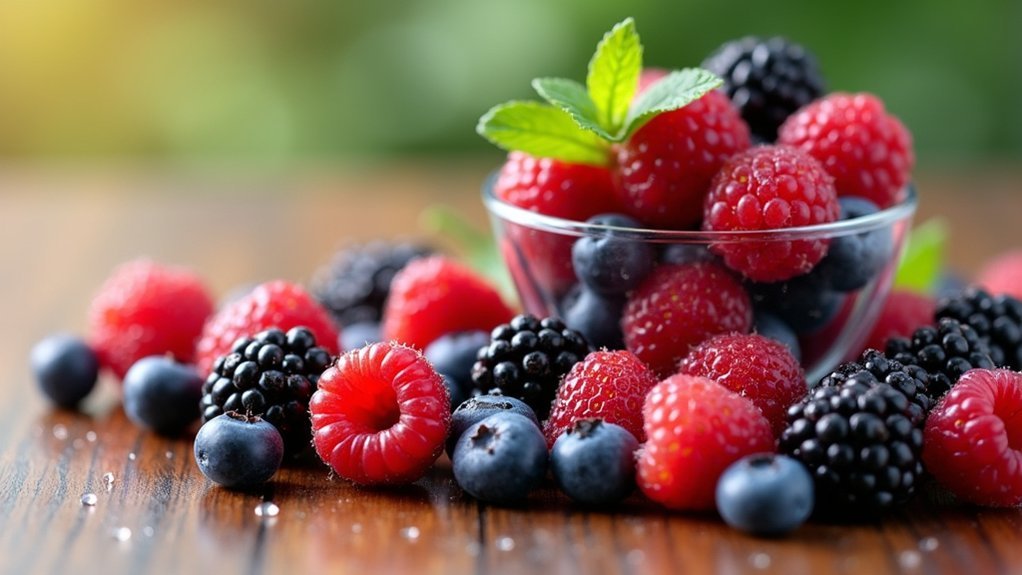
Although researchers have documented berry benefits for DNA protection, you’ll find that clinical studies reveal significant variability in ideal dosing recommendations.
Most research suggests 0.5–2 cups of fresh berries daily, with many trials using 150–250 grams per day. This typically provides 300–400 mg of polyphenols and 302–375 mg of anthocyanins when you consume blueberries.
You shouldn’t expect universal best doses since effects depend on berry type, individual metabolism, and absorption rates.
While some studies show modest gut microbiota improvements at standard doses, there’s no consistent dose-response relationship for DNA repair benefits. Studies indicate that more than 3 servings per week of blueberries are linked to a 34% lower risk of myocardial infarction.
Higher intakes approaching 4 cups daily aren’t routinely recommended outside research settings, and you won’t necessarily gain additional benefits from exceeding typical clinical doses.
Fresh Berries vs. Powders vs. Juices: Which Form Delivers Maximum Benefits
Which berry form should you choose to maximize cellular repair benefits? Fresh berries consistently outperform powders and juices in cellular repair studies.
You’ll get intact anthocyanins, flavonoids, and polyphenols working synergistically with natural fiber content. This combination slows sugar absorption while delivering maximum bioactive compounds to your cells.
Berry powders offer convenience and concentrated antioxidants but lose volatile phytochemicals during processing. You’re also getting reduced fiber content, which affects gut health benefits.
However, they’re shelf-stable and easy to incorporate into meals.
Berry juices provide rapid nutrient absorption but often lack fiber entirely. Commercial versions frequently contain added sugars and preservatives that dilute benefits.
Processing can oxidize sensitive polyphenols, reducing cellular repair efficacy. Studies show berries enhance blood flow to key brain areas during cellular repair processes.
For maximum cellular repair, choose fresh berries when possible, using powders as convenient alternatives.
Timing and Frequency Strategies for Sustained Cellular Protection
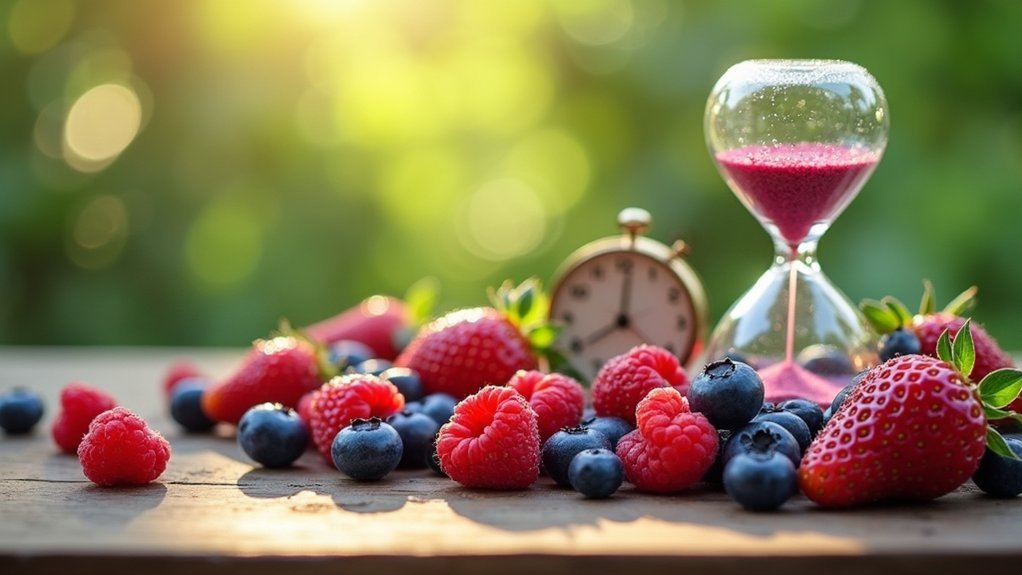
When you consume berries matters just as much as which berries you choose for cellular repair.
You’ll maximize antioxidant absorption by strategically timing your berry intake throughout the day, from morning cellular activation to evening damage repair.
Your body’s natural rhythm creates distinct windows where berry compounds can deliver peak protective benefits, making consistency and smart scheduling essential for sustained cellular health. The protective effect against DNA damage occurs within one hour of consumption but returns to baseline vulnerability within two hours.
Optimal Daily Timing
Since most berry studies focus on dosages rather than precise timing, you’ll find surprisingly few clear guidelines about when to consume berries for ideal cellular repair.
Research hasn’t established a single “optimal” daily timing through randomized controlled trials, and most studies report timing as incidental rather than a primary variable.
However, you can make practical decisions based on available evidence. Morning intake aligns well with daily antioxidant demands like sun exposure, while evening consumption could support overnight repair processes.
What matters most isn’t the exact timing but consistency—regular daily intake consistently modulates oxidative stress and inflammation better than intermittent consumption. Berry polyphenols require sustained levels in circulation to effectively inhibit low-density lipoprotein oxidation and support vascular health.
You’ll benefit more from establishing a sustainable routine than obsessing over perfect timing, since regularity trumps precision in current research.
Sustained Protection Patterns
Beyond establishing when to eat berries, you’ll want to understand how different consumption patterns create lasting cellular protection. Consistent daily intake provides sustained antioxidant activity, while rotating between different berry types delivers a broader spectrum of protective compounds like anthocyanins and polyphenols.
You can enhance protection by spreading consumption throughout the day rather than concentrating it in one meal. This approach maintains steady antioxidant levels and continuous inflammation reduction.
Combining berries with other fruits amplifies overall protective effects, while whole berries offer superior bioavailability compared to supplements. Research shows that berry polyphenols can reach the brain in sufficient concentrations to support cognitive health.
Long-term consumption patterns yield the most significant benefits for cardiovascular health, cognitive function, and chronic disease prevention. Your sustained berry intake strategy should prioritize consistency over intensity, creating cumulative protective effects that strengthen cellular repair mechanisms over time.
Cardiovascular and Neurological Repair Mechanisms Activated by Berry Compounds
As berry compounds enter your cardiovascular system, they immediately begin targeting multiple pathways that drive disease progression and cellular damage.
You’ll experience enhanced nitric oxide production as berries upregulate eNOS, improving blood vessel dilation and reducing blood pressure. The polyphenols simultaneously inhibit inflammatory NF-κB and MAPK signaling while scavenging reactive oxygen species that damage heart tissue.
Your endothelial function improves through reduced oxidative stress, preventing nitric oxide degradation and enhancing its protective effects. Berry anthocyanins actively lower LDL cholesterol levels and prevent foam cell formation in arterial walls. These cardiovascular benefits extend to stroke prevention as atherosclerosis in major organs decreases with consistent berry consumption.
Berry anthocyanins enhance endothelial function by reducing oxidative stress, protecting nitric oxide, and preventing arterial foam cell formation.
Key cardiovascular repair mechanisms include:
- Anti-inflammatory action – Myricetin reduces cardiac hypertrophy by blocking cellular stress pathways
- Vascular protection – Decreased nuclear translocation of pro-inflammatory factors prevents vascular remodeling
- Antioxidant defense – Suppressed NADPH oxidase activity limits ROS-mediated cellular damage
Personalizing Your Berry Intake for Individual Health Goals
While berry compounds deliver universal cellular repair benefits, optimizing your intake requires matching specific berry types and consumption patterns to your individual health goals and metabolic profile.
If you’re managing type 2 diabetes or insulin resistance, prioritize blueberries for their proven insulin sensitivity improvements through 6-12 week interventions.
When you’re overweight, substitute 50g of daily carbohydrates with blueberries to enhance weight loss and metabolic markers.
For cognitive protection against aging, maintain 1-2 weekly servings of darker berries rich in anthocyanins. Research suggests that higher doses of polyphenols at 500 mg per day may be necessary to effectively mitigate age-related cognitive decline.
Athletes should focus on post-workout berry consumption to accelerate muscle recovery.
If you can’t tolerate whole berries, standardized extracts like bilberry provide comparable glucose modulation benefits without digestive issues.
Frequently Asked Questions
Can Frozen Berries Provide the Same Cellular Repair Benefits as Fresh Ones?
You’ll get nearly identical cellular repair benefits from frozen berries since they’re flash-frozen at peak ripeness, preserving antioxidants and vitamin C that support cellular repair as effectively as fresh berries.
Do Berry Supplements Interact With Common Medications or Blood Thinners?
Berry supplements can interact with your medications and blood thinners. They may enhance anticoagulant effects, increasing bleeding risk, and affect drug absorption. You’ll need to consult your healthcare provider before taking berry supplements.
Are There Any People Who Should Avoid High Berry Consumption?
You should avoid high berry consumption if you’re taking warfarin, have kidney stones, IBS, or berry allergies. Those with chronic kidney disease or acid reflux should also limit intake carefully.
How Long Does It Take to See Measurable Cellular Repair Improvements?
You’ll notice biomarkers of oxidative stress and inflammation improve after 2-8 weeks of consistent berry consumption. For cognitive benefits, you’ll need 8+ weeks, while skin improvements require 4-12 weeks of regular intake.
Can Children and Elderly Adults Safely Consume the Same Berry Amounts?
You shouldn’t give children and elderly adults identical berry amounts. You’ll need to adjust portions based on age, weight, and individual health conditions, though both groups generally tolerate berries well.
In Summary
You’ll maximize cellular repair by consuming 1-2 cups of mixed berries daily, preferably fresh or frozen, spread throughout your morning and afternoon. Don’t rely solely on juices or supplements—whole berries deliver superior antioxidant absorption. Time your intake around meals for ideal bioavailability, and rotate between blueberries, strawberries, and blackberries to target different cellular pathways. You’ll see measurable DNA protection and enhanced cardiovascular function within weeks of consistent consumption.

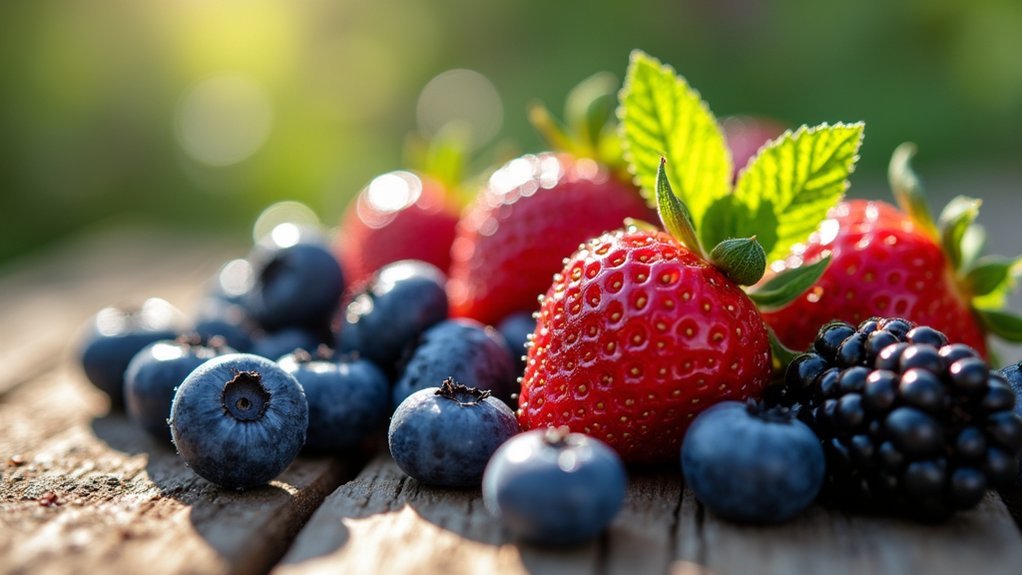
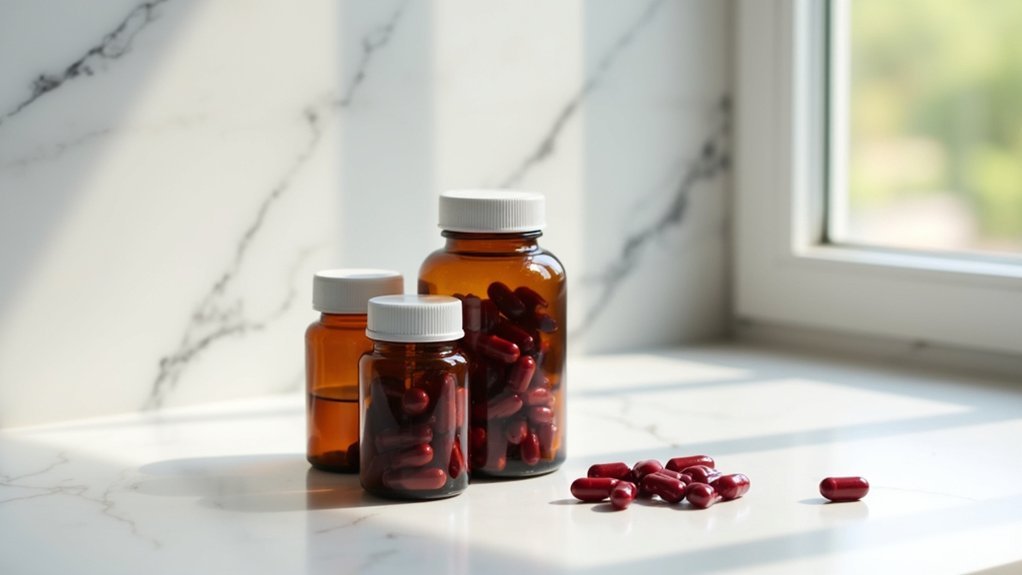
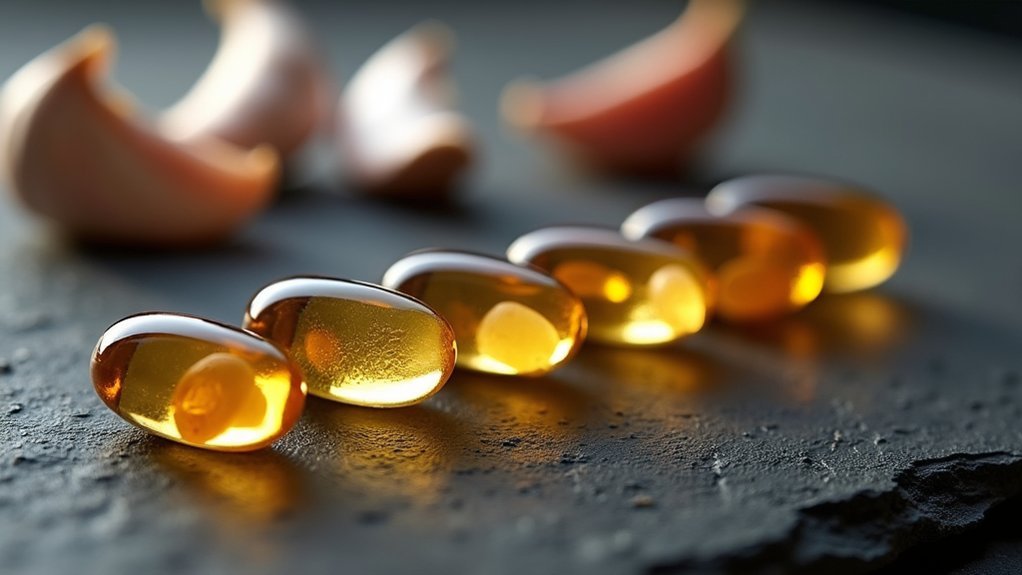
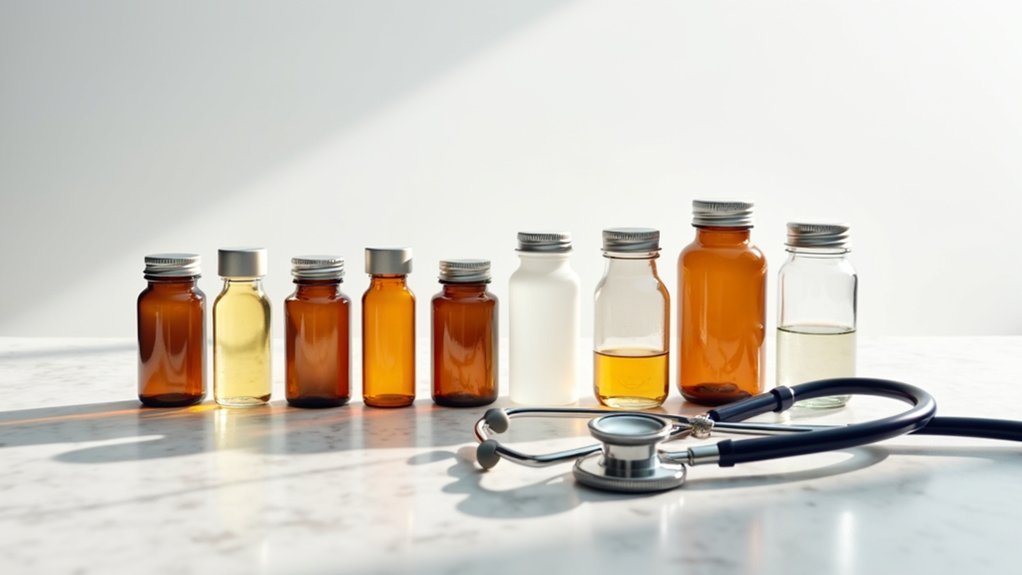
Leave a Reply